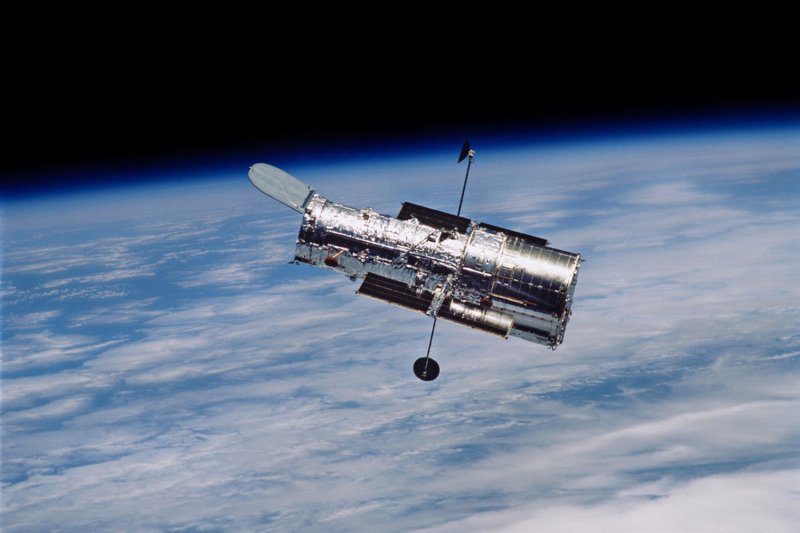1 of 4 | The Hubble Space Telescope celebrated its 28th birthday this month, having delivered images of faraway stars and star systems and greatly expanded scientists' understanding of the universe since it's launch on April 19, 1990. File Photo by NASA/UPI |
License Photo
April 24 (UPI) -- Today, astronomers know the age and size of the universe with greater certainty and precision than they did 28 years ago, thanks to 28 years of working with the Hubble Space Telescope.
"When I was a grad student 30 years ago, we were arguing about the size and scale of the universe," NASA scientist Jeff Hayes told UPI.
Hayes has said those arguments featured estimates differing by a factor of two.
"Today, thanks to Hubbles' observations, we are down to a couple of percent," he said.
Hubble was designed to measure the size and age of the universe, as well as the rate of its expansion, and it succeeded in doing just that. Hayes said this has been Hubble's biggest breakthrough.
The telescope was launched on April 19, 1990. It celebrated its 28th anniversary on Thursday with a remarkable double portrait of the Lagoon Nebula. That release was followed up Monday by stunning video of spiral galaxies colliding.
Just a month after its launch, on May 20, 1990, Hubble snapped its first photograph, an underexposed shot of the Milky Way star cluster known as NGC 3532. In the years since, Hubble has garnered a lot of attention for its ability to render the cosmos in stunning color and detail, but it's also been responsible for some important scientific breakthroughs.
After eight years of studying the variable light of Cepheids, a type of pulsating star, as well as the emissions of distant supernovae, Hubble helped scientists peg the age of the universe at roughly 13.7 billion years.
Observations made during the telescope's first decade in space also helped scientists measure the acceleration of the universe, the so-called Hubble Constant. Researchers determined the universe's expansion increases by 43 miles per second for every 3.26 million light-years one travels farther into outer space.
After helping scientists accomplish their initial scientific goals, Hubble didn't slow down.
Hayes said the telescope's second-biggest breakthrough came only recently, when it helped astronomers confirm the optical origin of the gravitational waves produced by a neutron star collision.
"The LIGO and Virgo detectors, of course, first observed the gravitational waves, but Hubble located the optical counterpoint, and that's really, really cool," Hayes said.
Hubble has also advanced astronomers' understanding of the life cycle of stars.
"Thanks to Hubble, we now have the ability to see stars as they're coalescing and forming, as well as study the deaths of the stars and the interesting planetary nebulae that result," Hayes said.
Hubble hasn't always been perfect.
Though it was launched in 1990, some of the telescope's technology was more than a decade old by the time it was conducting science.
"It was designed in the 1970s, so the technology was very '70s," Hayes said.
The photomultiplier tubes used on Hubble offered extreme sensitivity to a variety of wavelengths, but they were a bit wily in space.
"You want solid state devices in space, we learned that lesson very quickly," Hayes said.
That some of Hubble's early tech was outdated wasn't the only issue. Shortly after Hubble's launch, scientists discovered one of the telescope's mirrors had been ground and polished to the wrong shape, causing light reflected off the mirrors perimeter to focus on a point different than that of light reflected off the mirror's center.
While Hubble could still capture high-resolution images of bright, nearby stars, it was unable to produce focused images of faint, distant objects, which meant the telescope couldn't carry out its original scientific programming until a correction was made.
Though NASA scientists designed and eventually installed a corrective mirror during an early Hubble servicing mission, the mistake prompted some politicians to question NASA's future.
"I think this has seriously hurt the credibility of NASA when they've had so much time and enough money to get it right," said Sen. Barbara Mikulski, D-Md. "You want to go more into space, you want to go to Mars. What would we do if we had sent astronauts out and the life-support failed? Say 'Oh, no! We forgot to send you lunch -- and oxygen.'"
That Hubble was designed to be regularly serviced proved a lifesaver and allowed NASA to salvage the Hubble mission and its reputation. The telescope's ability to bounce back from hardship may be a credit to its namesake, Edwin Hubble. In addition to pioneering a number of breakthroughs in the fields of astronomy and cosmology -- including the discovery of galaxies -- Hubble was an accomplished basketball player and boxer, recording a knockout against a German heavyweight champion.
Hubble's tech has been upgraded over the years, and Hayes said the space telescope has really helped drive the growth of optics technology.
"Solid state detectors are now way more efficient at a larger range of wavelengths," he said.
There's a lot of buzz about NASA's James Webb Space Telescope, which is due to launch in 2020. While Hubble will no longer be the top dog, it will still be essential. Hubble's smaller, wide-angle lens will continue to survey the skies in search of interesting cosmic phenomena -- phenomena that JWST can explore in even greater detail.
"The relationship between James Webb and Hubble will be synergistic, as much as I hate to use that term," Hayes said.
At least for a couple years, however, Hubble will remain king.















